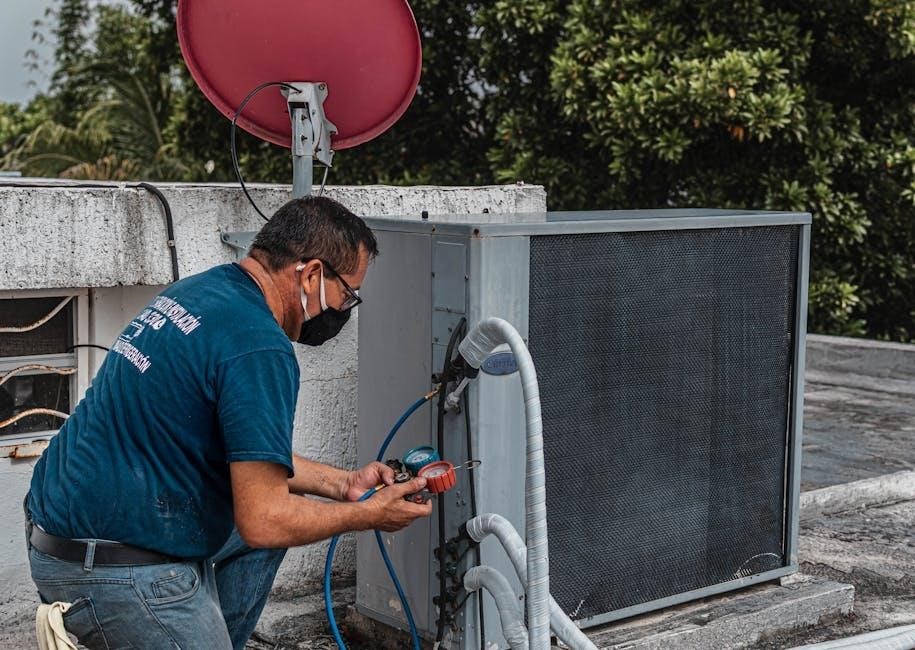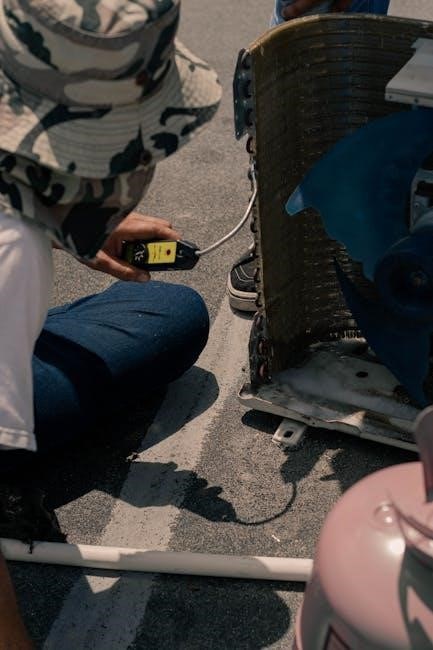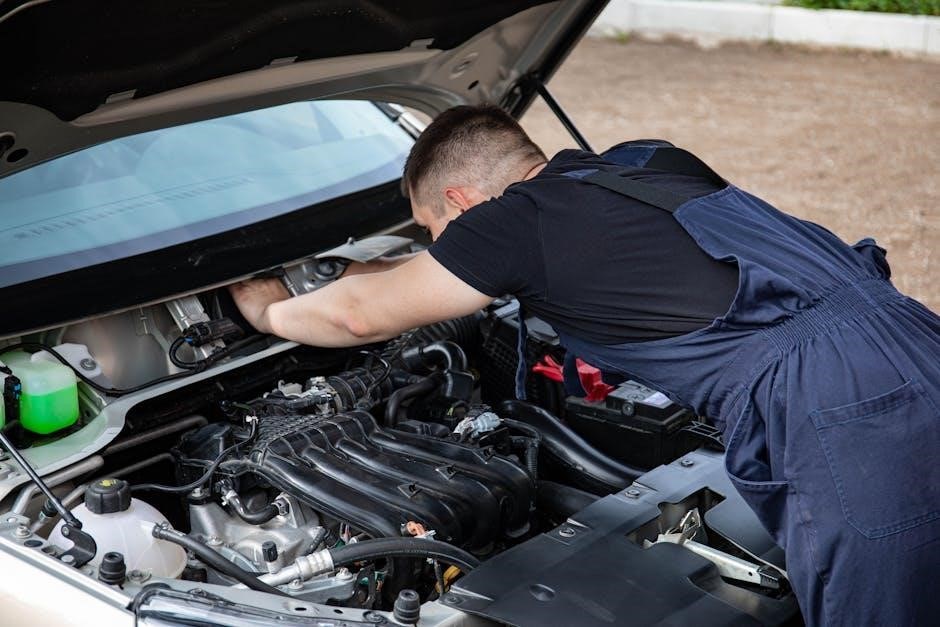This manual provides essential guidance for diagnosing and resolving issues with the Thermo King Tripac system, designed for drivers, technicians, and fleet managers. It covers common problems, troubleshooting steps, and maintenance tips to ensure optimal performance and reliability. By following the outlined procedures, users can address electrical, mechanical, and temperature control issues efficiently, minimizing downtime and extending system lifespan. The guide adheres to industry standards and best practices, making it a comprehensive resource for Tripac system maintenance and repair.
Overview of the Thermo King Tripac System
The Thermo King Tripac system is a advanced temperature control and idle reduction solution designed for trucks and other vehicles. It combines an auxiliary power unit (APU) with temperature management, reducing engine idle time and lowering fuel consumption. The system includes key components such as a compressor, condenser, evaporator, and controller, working together to maintain consistent temperatures and provide reliable power. Regular maintenance is crucial to ensure optimal performance, as outlined in the troubleshooting manual. Users can refer to official manuals and diagnostic guides for detailed instructions on addressing common issues. Additionally, Thermo King offers a network of dealers and online resources for further assistance. By understanding the system’s operation and following recommended procedures, users can maximize efficiency and extend the lifespan of their Tripac unit. This overview provides a foundation for troubleshooting and maintaining the system effectively.
Importance of Regular Maintenance and Troubleshooting
Regular maintenance and troubleshooting are critical to ensuring the Thermo King Tripac system operates efficiently and reliably. Neglecting routine checks can lead to premature wear, increased fuel consumption, and unexpected breakdowns, which can result in costly repairs and downtime. By following the recommended maintenance schedule and addressing issues promptly, users can prevent minor problems from escalating into major ones. Proper care also ensures optimal temperature control, reduces emissions, and maintains compliance with environmental regulations. Additionally, regular troubleshooting helps identify potential issues early, minimizing disruptions to operations. Investing time in maintenance and troubleshooting not only extends the system’s lifespan but also enhances overall performance, ensuring the Tripac unit continues to provide reliable service. This proactive approach is essential for maximizing efficiency and reducing long-term costs.

Understanding the Thermo King Tripac System
The Thermo King Tripac system is a robust temperature control solution designed for trucks and trailers, ensuring precise temperature management. It integrates advanced components like compressors, evaporators, and condensers, working seamlessly to maintain optimal conditions. The system is known for its reliability, efficiency, and adaptability, making it a preferred choice for refrigerated transportation. Its operation involves a cycle of compression, condensation, expansion, and evaporation to regulate temperature effectively. Understanding its core functions and components is essential for effective troubleshooting and maintenance, ensuring uninterrupted performance and extending its lifespan.
Key Components of the Tripac System
The Thermo King Tripac system consists of several critical components essential for its operation. The compressor serves as the heart of the system, driving the refrigeration cycle. The condenser is responsible for dissipating heat, while the evaporator absorbs heat from the surrounding air. The expansion valve regulates the flow of refrigerant, ensuring proper pressure and temperature control. Additionally, the controller is the brain of the system, managing operations, diagnostics, and user settings. Other key components include the electrical system, which powers the unit, and the coolant system, which manages heat exchange. Each part plays a vital role in maintaining the system’s efficiency and reliability, making them crucial for troubleshooting and maintenance. Understanding these components is essential for diagnosing and resolving issues effectively, ensuring the system operates at peak performance.
How the Tripac System Operates
The Thermo King Tripac system operates by utilizing a refrigeration cycle to regulate temperature within a vehicle. It begins with the compressor, which compresses refrigerant, raising its temperature and pressure. The hot refrigerant gas then flows to the condenser, where it cools down and condenses into a liquid. This liquid refrigerant passes through the expansion valve, which reduces its pressure and allows it to expand. The cold, low-pressure refrigerant then enters the evaporator, where it absorbs heat from the surrounding air, cooling the vehicle. Finally, the refrigerant, now a gas, returns to the compressor to complete the cycle. The system is controlled by an advanced controller that monitors and adjusts operations based on user settings and environmental conditions. This continuous process ensures efficient temperature management, making the Tripac system a reliable solution for maintaining cargo integrity during transport.
Common Features and Capabilities
The Thermo King Tripac system is equipped with a range of advanced features designed to enhance performance and user convenience. Key capabilities include dual-mode operation, allowing seamless switching between diesel and electric power sources, and smart start technology to reduce startup issues. The system also features precise temperature control, with adjustable settings to maintain optimal conditions for various cargo types. Advanced diagnostics provide real-time monitoring and error notifications, while the intuitive controller offers an easy-to-use interface. Additionally, the Tripac system supports remote monitoring through mobile apps, enabling drivers and fleet managers to track performance and address issues remotely. These features, combined with its robust design, make the Tripac system a versatile and reliable solution for temperature management in demanding environments. Its capabilities ensure efficient operation, reduced downtime, and improved cargo protection.

Common Issues and Troubleshooting Steps
Common issues with the Thermo King Tripac include electrical faults, error codes, and temperature control malfunctions. Troubleshooting involves diagnosing root causes, such as faulty sensors or wiring, and applying targeted solutions to restore functionality.
Electrical Issues and Solutions
Electrical issues in the Thermo King Tripac system often manifest as error codes like ALT or ALf, indicating faults in the alternator or wiring. Drivers should start by checking the battery connections and ensuring the alternator belt is properly tensioned. Faulty sensors or corroded connectors can also cause electrical malfunctions. To resolve these, inspect and clean all connections, and replace damaged components if necessary. Additionally, ensure the system’s wiring harness is secure and free from damage. If issues persist, consult the Tripac’s diagnostic manual or use specialized tools to pinpoint the problem. Regularly testing the battery and alternator can prevent such issues. Always refer to the official Thermo King troubleshooting guide for detailed instructions, and contact a certified technician if complex repairs are required. Addressing electrical problems promptly ensures reliable operation and minimizes downtime.
Mechanical Issues and Solutions
Mechanical issues in the Thermo King Tripac system often involve the engine, coolant system, or moving parts. Common problems include coolant leaks, low coolant levels, or air in the system, which can cause overheating or reduced performance. To address these, check the coolant reservoir and hoses for leaks, and bleed the system if air is present. A loose serpentine belt can also lead to poor operation; inspect and tighten it according to manufacturer specifications. Additionally, ensure the evaporator and condenser coils are clean, as debris can impede airflow and affect cooling efficiency. For complex mechanical repairs, such as faulty compressors or internal engine issues, it’s best to consult a certified Thermo King technician. Regular maintenance, such as checking fluid levels and belt tension, can prevent many mechanical issues and ensure reliable operation. Always follow the recommended procedures outlined in the official manual for optimal results.
Temperature Control Issues and Solutions
Temperature control issues in the Thermo King Tripac system can arise from faulty sensors, malfunctioning valves, or improper system calibration; If the unit fails to maintain the set temperature, check the temperature sensors for accuracy and ensure they are clean. A faulty thermistor or sensor may require replacement. Additionally, low refrigerant levels can impact cooling performance; inspect for leaks and recharge if necessary. Airflow restrictions, such as blocked condenser or evaporator coils, can also disrupt temperature regulation. Regularly cleaning these components can resolve such issues. For advanced problems, such as inconsistent heating or cooling, consult the diagnostic manual for specific alarm codes. Resetting the system or recalibrating the controller may also restore proper function. Always refer to the official troubleshooting guide for detailed instructions and ensure compliance with manufacturer recommendations to maintain optimal temperature control performance. Addressing these issues promptly prevents further complications and ensures reliable operation.
Software and Controller Issues and Solutions

Software and controller issues in the Thermo King Tripac system can cause operational disruptions, such as error codes or system malfunctions. Common problems include outdated software, faulty controller connections, or incorrect system calibration. If an error code appears, refer to the diagnostic manual (e.g., TriPac Evolution Diagnostic Manual TK 55739) for specific solutions. For example, codes like ALT or ALf may indicate electrical faults that require resetting the system or replacing damaged components. Regular software updates can prevent compatibility issues and improve performance. If the controller fails to respond, check for loose connections or corrupted software and restart the system. For persistent issues, contact the nearest Thermo King dealer for professional assistance. Always use authorized diagnostic tools and follow manufacturer guidelines to ensure proper system functionality and avoid further complications. Timely resolution of these issues is crucial for maintaining reliable temperature control and overall system efficiency.

Maintenance Tips for Optimal Performance
Regular maintenance is crucial for optimal performance. Follow factory-recommended procedures and perform routine checks to prevent issues, ensure efficiency, and extend system lifespan.
Recommended Maintenance Schedule

A well-structured maintenance schedule is essential for ensuring the Thermo King Tripac system operates efficiently. Begin with daily checks of coolant levels, oil levels, and belt condition. Weekly, inspect air filters, hoses, and electrical connections for signs of wear or damage. Monthly, drain and refill coolant, and clean condenser coils to prevent overheating. Every 3-6 months, replace air filters and inspect the compressor and evaporator for leaks. Annually, perform a full system inspection, including the battery, alternator, and thermostat. Always refer to the factory-recommended maintenance intervals for specific tasks. Adhering to this schedule helps prevent breakdowns, reduces repair costs, and ensures reliable temperature control. Regular maintenance also extends the lifespan of the system, making it a critical part of fleet management and operational efficiency.
Best Practices for System Inspection
Regular and thorough inspections are crucial for maintaining the Thermo King Tripac system’s performance and reliability. Start by visually examining the exterior for damage, rust, or blockages in the condenser and evaporator coils. Check electrical connections for tightness and signs of wear, ensuring all components are securely fastened. Inspect air filters and clean or replace them as needed to prevent airflow restrictions. Examine coolant lines for leaks and ensure the coolant level is within the recommended range. Also, inspect drive belts for cracks or wear and replace them if necessary. Use specialized tools to check for refrigerant leaks and verify proper system pressure. Document all findings and address any issues promptly to prevent minor problems from escalating. Always refer to the official Thermo King manual for specific inspection procedures and guidelines.
How to Perform Routine Checks
Performing routine checks on the Thermo King Tripac system ensures optimal functionality and prevents unexpected breakdowns. Begin by powering off the unit and allowing it to cool down before starting the inspection. Check the air filter for cleanliness and replace it if necessary to maintain proper airflow. Inspect the condenser and evaporator coils for dirt or debris, cleaning them gently with a soft brush or compressed air. Verify that all electrical connections are secure and free from corrosion. Examine the coolant level and top it off if required, using the recommended type to avoid contamination. Inspect the drive belt for signs of wear, adjusting or replacing it as needed. Use a multimeter to test battery voltage and ensure it meets specifications. Finally, run a test cycle to ensure the system operates smoothly and check for any error codes or alarms. Address any issues promptly to maintain efficiency and reliability.

Advanced Diagnostic Techniques
Advanced diagnostics involve decoding error codes, using multimeters for electrical testing, and employing specialized software tools to identify and resolve complex issues within the Thermo King Tripac system effectively.
Understanding Diagnostic Codes and Alarms
Diagnostic codes and alarms play a crucial role in identifying issues within the Thermo King Tripac system. These codes, such as ALT or ALf, indicate specific faults, guiding technicians to the root cause. Referencing the official TriPac Evolution Diagnostic Manual (TK 55739) is essential for accurate interpretations. Alarms often relate to temperature deviations, low coolant levels, or electrical malfunctions. Understanding these codes enables quick resolutions, minimizing downtime. For instance, an ALT code may signal an alternator issue, while ALf could indicate a low fuel condition. Always consult the manual or contact a certified Thermo King technician for unresolved issues. Regular system checks can prevent alarms from escalating into major problems, ensuring smooth operation and maintaining cargo integrity.
Using Specialized Tools for Diagnosis
Specialized tools are essential for effectively diagnosing issues with the Thermo King Tripac system. The TriPac Evolution Diagnostic Manual (TK 55739) is a key resource, providing detailed explanations of diagnostic codes and procedures. A multimeter can help identify electrical faults, such as voltage drops or open circuits, while a pressure test kit is useful for detecting leaks in the cooling system. Additionally, Thermo King offers a range of proprietary diagnostic software that can communicate directly with the system’s controller, offering real-time data and fault codes. For complex issues, contacting a certified Thermo King technician or utilizing the Thermo King Dealer Network is recommended. These tools and resources ensure accurate diagnoses, enabling swift and effective repairs to maintain system performance and reliability. Regular use of these tools can also help prevent issues before they escalate.
Advanced Troubleshooting Techniques
Advanced troubleshooting for the Thermo King Tripac system involves a combination of diagnostic expertise and specialized techniques. One key method is interpreting diagnostic codes from the system’s controller, which provide specific insights into faults. System recalibration and advanced fault isolation are also critical, often requiring access to proprietary software. Additionally, technicians may perform detailed analysis of temperature control parameters, electrical circuits, and coolant flow to pinpoint issues. Online forums and videos, such as those on TikTok, share real-world solutions from experienced users, offering practical tips for resolving complex problems. Consulting the TriPac Evolution Diagnostic Manual (TK 55739) is essential for understanding alarm codes and advanced repair procedures. By combining these techniques with regular maintenance, users can address even the most challenging issues effectively. This approach ensures the Tripac system operates at peak performance, minimizing downtime and extending its lifespan.

Resources for Further Assistance
- Thermo King Dealer Network: Access certified support, parts, and expert advice through authorized dealers.
- Official Manuals and Guides: Refer to the TriPac Evolution Diagnostic Manual (TK 55739) for detailed troubleshooting procedures.
- Online Forums and Communities: Engage with forums and platforms like TikTok for real-world solutions and tips from experienced users.
Thermo King Dealer Network and Support
The Thermo King dealer network provides comprehensive support for Tripac systems, offering certified technicians, genuine parts, and expert guidance. Dealers are equipped to handle complex repairs, ensuring your unit operates efficiently. Contacting a dealer is the first step for warranty claims or advanced diagnostics. They also offer preventive maintenance programs tailored to your needs. For urgent issues, many dealers provide 24/7 emergency support. Visit the official Thermo King website to locate your nearest dealer and access a range of resources designed to keep your Tripac system running smoothly. This network is a vital resource for professional and reliable assistance, ensuring minimal downtime and optimal performance.

Online Forums and Communities
Online forums and communities are valuable resources for Thermo King Tripac troubleshooting, offering peer-to-peer support and real-world insights. Platforms like Reddit, Facebook groups, and specialized trucking forums host discussions where drivers and technicians share experiences, solutions, and advice. These communities often provide quick fixes, workarounds, and tips for common issues, helping users troubleshoot effectively. For example, TikTok videos and YouTube tutorials demonstrate hands-on repairs and diagnostics, while forums like TruckersReport and Diesel Forum feature detailed threads on Tripac-specific problems. These resources complement official manuals, offering practical, community-driven solutions. They also allow users to connect with experienced professionals and gain insights into maintaining and repairing their systems. By engaging with these communities, users can access a wealth of knowledge and stay updated on the latest troubleshooting techniques. This collaborative approach enhances problem-solving and fosters a supportive environment for Tripac users worldwide.
Official Manuals and Guides
Official Thermo King manuals and guides are essential resources for troubleshooting and maintaining the Tripac system. These documents provide detailed instructions, diagrams, and specifications for diagnosing and resolving issues. The Tripac Evolution Diagnostic Manual (TK 55739) is a key resource, offering in-depth information on alarm codes, system operations, and repair procedures. Additionally, service manuals and user guides are available through Thermo King’s official website or authorized dealers. These materials include step-by-step troubleshooting processes, maintenance schedules, and parts lists. They are designed to help users understand system functionality and address problems effectively. By following the guidelines in these manuals, technicians and drivers can ensure compliance with manufacturer recommendations, optimizing system performance and longevity. Official manuals are indispensable for anyone working with the Thermo King Tripac, providing authoritative guidance for all aspects of system maintenance and repair.
The Thermo King Tripac Troubleshooting Manual is an invaluable resource for drivers and technicians, offering comprehensive solutions for common issues. Regular maintenance and adherence to guidelines ensure optimal performance and longevity. As technology advances, staying informed about updates and innovations will be crucial for maximizing efficiency and reliability in the future.

The Thermo King Tripac troubleshooting process emphasizes identifying symptoms, checking diagnostic codes, and addressing root causes. Start with basic checks like power supply, coolant levels, and air filters. For electrical issues, inspect wiring and connections, while mechanical problems may require checking belts or hoses. Temperature control issues often involve sensors or refrigerant leaks. Use specialized tools like the TK ReDAQ system for advanced diagnostics. Always refer to the official manual for specific procedures and ensure proper safety precautions. Regular maintenance, such as cleaning coils and replacing filters, prevents many common issues. If problems persist, consult a certified Thermo King technician or dealership. By following these strategies, users can resolve issues efficiently, minimizing downtime and ensuring reliable operation.
Future Trends in Thermo King Technology
Thermo King is advancing its technology to meet evolving industry demands, focusing on sustainability, connectivity, and efficiency. Future systems are expected to integrate advanced telematics and IoT capabilities for real-time monitoring and remote diagnostics. Electrification of auxiliary power units (APUs) and hybrid systems will likely become more prevalent, reducing emissions and operating costs. Enhanced software capabilities, including predictive maintenance and AI-driven diagnostics, will enable proactive issue resolution. Energy-efficient designs and alternative fuel solutions are also being explored to align with global environmental goals. Additionally, Thermo King is investing in user-friendly interfaces and mobile apps to streamline troubleshooting and maintenance processes. These innovations aim to enhance performance, reduce downtime, and support the growing needs of fleets and drivers in a competitive market.
